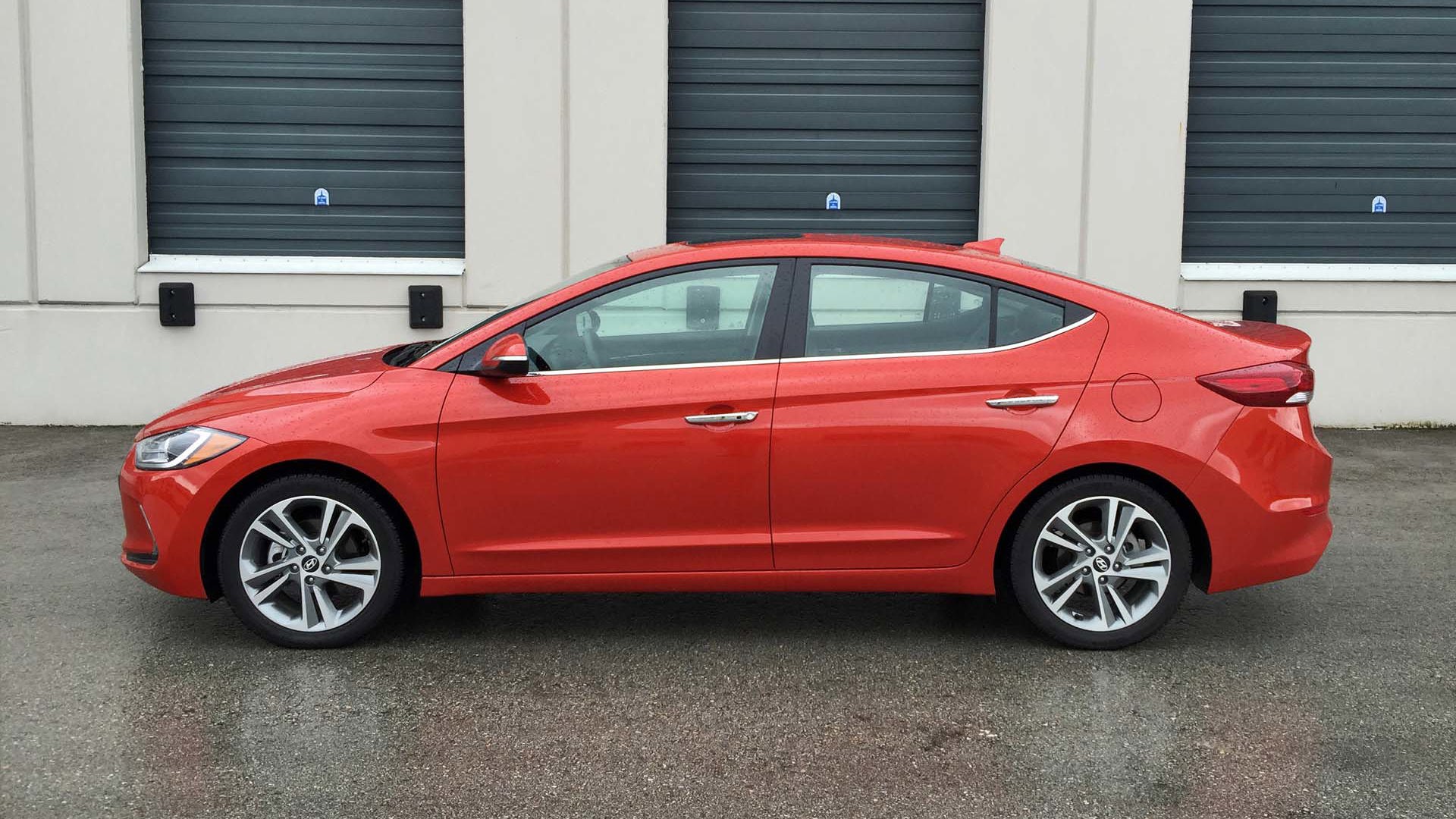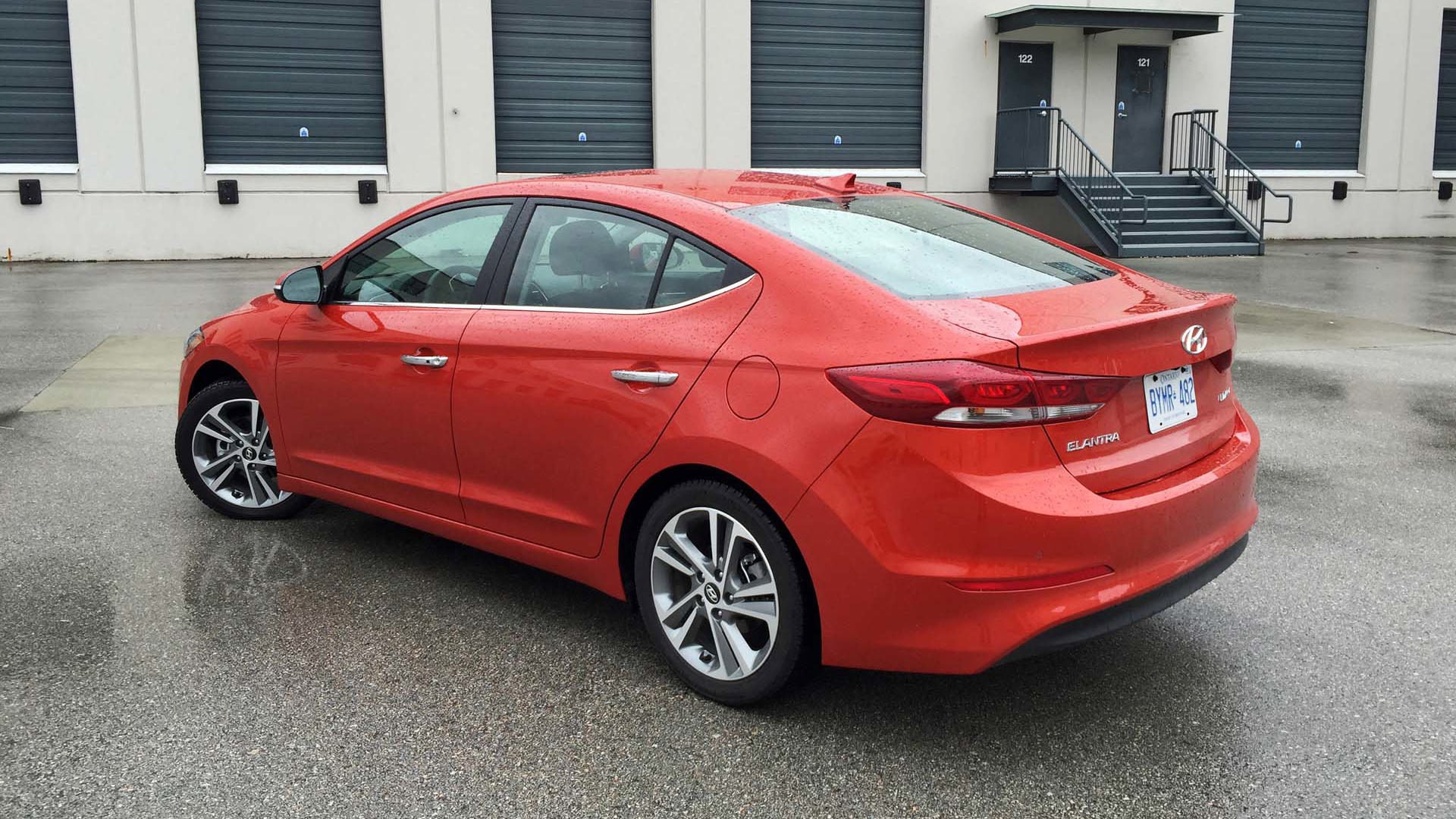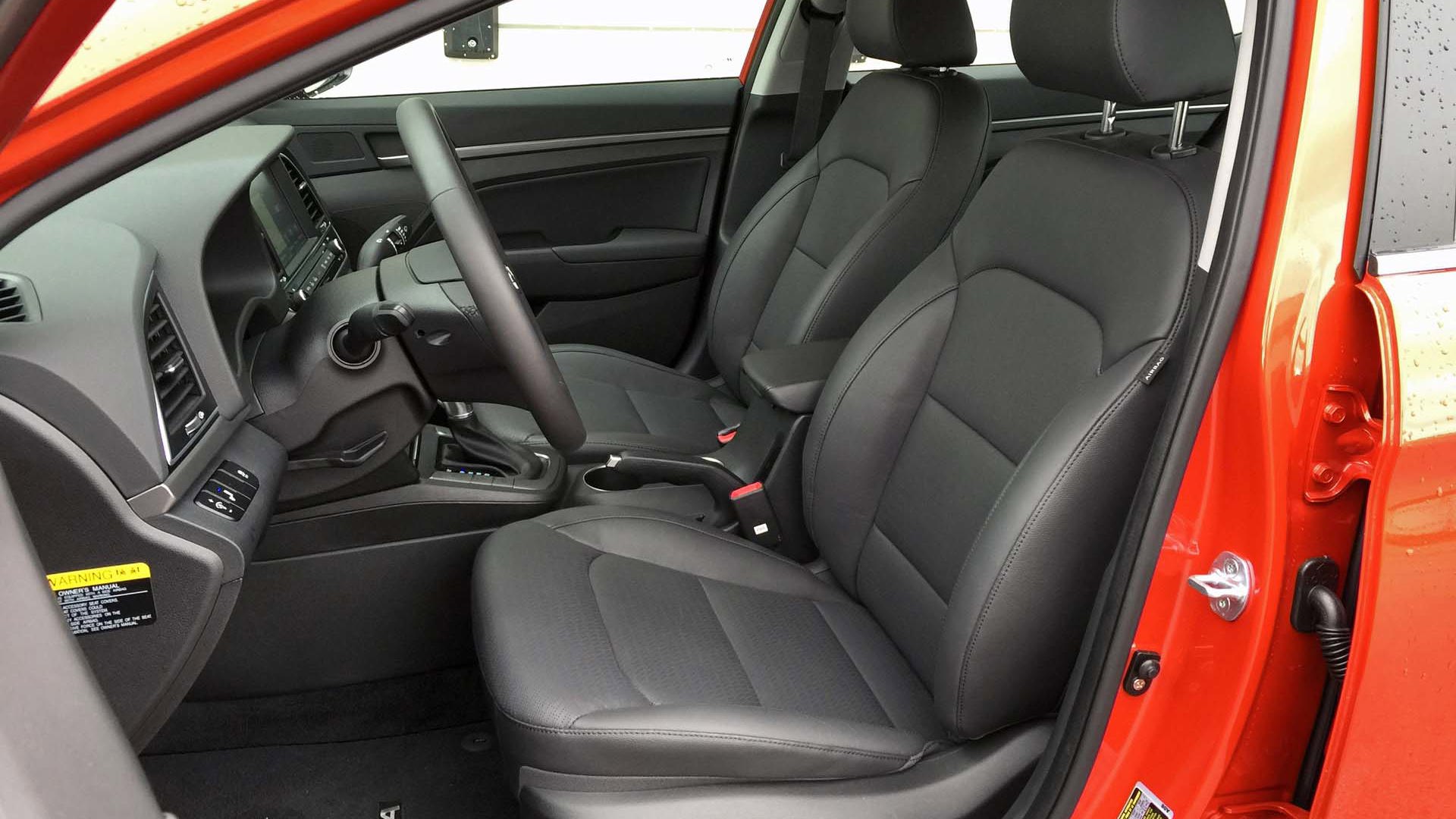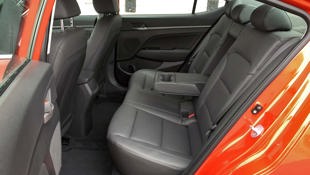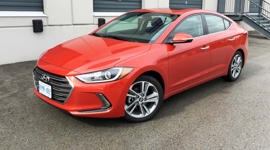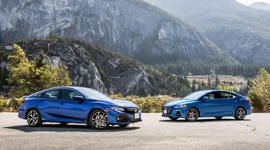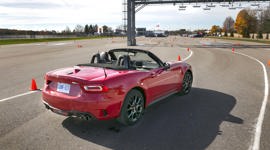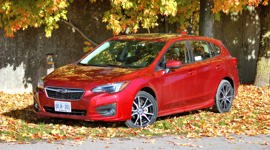 AutoTrader SCORE
AutoTrader SCORE
-
EXTERIOR STYLING7/10
-
INTERIOR8/10
-
PERFORMANCE7/10
-
COMFORT8/10
-
FUEL ECONOMY8/10
When the redesigned fifth-generation Hyundai Elantra sedan arrived in 2011, its "fluidic sculpture" exterior styling and curvy interior design looked decidedly different from mainstream competitors like the Corolla, Civic, Sentra and Jetta. The Elantra’s short sculpted hood, bulging wraparound headlight covers, prominent front fender bulges, ascending side-panel creases and extra-long wraparound taillight covers were a fresh approach in a generally conservative class.
Hyundai is probably betting that the Elantra sedan’s more conservative styling, like vanilla ice-cream, is going to appeal to a wider demographic. They might be right.
Canadians liked what they saw and Elantra sales skyrocketed. Last year, the Elantra was still the third-best-selling passenger car behind the Corolla and Civic.
Fast forward to the recently redesigned 2017 Elantra sedan and it’s obvious there’s been a U-turn in Hyundai’s design strategy. Instead of emphasizing bold styling and horsepower superiority, Hyundai switched its focus to more generic styling and better fuel economy along with increased cabin roominess, improved interior ergonomics, reduced cabin noise, and a more comfortable ride.
While still recognizable as an Elantra, the 2017 model has a horizontal profile with less-aggressive body creases and a fastback roofline that now extends all the way to the trunk lip (similar to the new Civic sedan) where there is a slightly upturned spoiler. A larger hexagonal grille opening with five slats is similar to other Hyundai models and echoes the big grille craze that started at Audi, Ford, Toyota, Mazda, etc.
Hyundai is probably betting that the Elantra sedan’s more conservative styling, like vanilla ice-cream, is going to appeal to a wider demographic. They might be right. So far this year, the Elantra is still number three in sales. However, that may include sales of the 2016 Elantra sedan and GT hatchback.
The 2017 Elantra sedan is slightly larger than the old one – externally, it’s about the same size as a Mazda3 sedan – and as before, it is classified as a "mid-size" car by the EPA (as are its key competitors, the Honda Civic sedan and Toyota Corolla.) Compared to the 2016 Elantra, the new model is 20 mm longer, 5 mm wider and 5 mm taller, but the wheelbase length hasn’t changed. Overall interior volume is actually down slightly (3,120 L vs 3,127 L), but the cabin is slightly larger (2,713 L vs 2,707 L) and the trunk is slightly smaller (407 L vs 420 L).
Trim levels have been simplified for the 2017 model year: L ($15,999), LE ($18,499), GL ($20,349), GLS ($22,699), Limited ($26,249) and a new Ultimate trim level ($28,799) at the top of the range. 2017 MSRPs are up by about $200 to $400, and Hyundai Canada is trying to get rid of remaining 2016 Elantra sedans by offering a generous $3,500 rebate on most trim levels.
All trim levels of the 2017 Elantra sedan receive a new 147 hp, 2.0L, Atkinson-cycle four-cylinder engine with multi-port injection that replaces both previously available engines – a 138 hp, 1.8L port-injection four-cylinder engine and a 173 hp, 2.0L, direct-injection engine. An Atkinson-cycle engine delays intake valve timing to improve fuel efficiency; in terms of horsepower, the 2017 Elantra runs behind the Honda Civic (158 hp) and Mazda3 (155 hp), but ahead of the Toyota Corolla (132). (The 128 hp turbocharged four-cylinder engine available in the U.S. is not offered in Canada.)
A second opinion: 2017 Hyundai Elantra Limited Test Drive
As is the trend nowadays, a manual transmission is no longer available in most Elantra trim levels; only the base Elantra L is still available with a six-speed manual transmission and all the rest get a standard six-speed automatic transmission with manual sequential shift capability.
The 2017 Elantra’s new engine offers better fuel economy than the previous 2.0L engine but it’s not class-leading. According to the EPA, the new Elantra’s 2.0L Atkinson-cycle engine paired with the standard six-speed automatic transmission rates 7.4 L/100 km combined city/hwy while the old 2.0L engine provided 8.4 L/100 km combined (the 2016 Elantra’s 1.8L engine offered 7.4 L/100 km combined). Among its competitors, the Honda Civic sedan (2.0L, CVT) offers 6.7 L/100 km while the Mazda3 sedan (2.0L, six-speed auto) offers 6.9 L/100 km combined.
With less horsepower and torque, the 2017 Elantra sedan’s performance has suffered somewhat. A combination of reduced horsepower and additional curb weight (approximately 24 kg) results in slower acceleration times.
Behind the wheel though, the new Elantra doesn’t feel slow or underpowered, but it does feel smoother and quieter. Improved structural rigidity, more sound insulation, thicker glass and improved bushings have all contributed to a quieter cabin and a revised torque converter helps improve shift response and engagement.
New this year is a driver-selectable Drive Mode with Eco, Sport and Normal settings that adjust throttle response, transmission shift timing and steering feel to suit the level of performance required (the previous Drive mode just altered steering weight). In my test drive, Eco mode left me feeling that the car needed more power, Normal mode felt just fine for everyday commuting, and Sport mode was great for zipping in and out of lanes in traffic, accelerating quickly from a traffic light, or adding some excitement to a challenging road. So despite its drop in horsepower, I didn’t get the impression that the new Elantra sedan was an underperformer.
It’s very pleasant on the freeway: the engine revs at just over 2,000 rpm in Normal mode, and there is minimal engine, wind and tire noise, even though my test car was still equipped with Michelin X-Ice 225/45R17-inch winter tires.
The driver’s visibility is generally good but the high rear deck makes the rear view rather narrow. A standard wide-angle rearview camera with parking guidelines really helps back the car into tight parking spaces. I also appreciated the rear parking sensors which beep more frequently as the vehicle approaches an obstacle. A standard blind spot warning system also helps to warn of other vehicles in the right or left blind spots when attempting to change lanes.
The best thing about the new Elantra sedan, apart from its improved on-the-road refinement, is the design of the new interior. The 2017 Elantra’s redesigned dash layout has more of a conventional, horizontal appearance than the previous curvy dash and while the styling is less adventurous, I found it more practical in everyday use. A larger 8.0-inch touchscreen (formerly 7.0-inch) is now angled slightly towards the driver instead of pitched forwards, so it’s easier to see and there’s less glare. The screen is also wide enough for a split-screen view, such as of currently playing audio and the navigational map.
Below the touchscreen, a wider centre stack allows more room for larger, easier-to-see buttons and a simpler layout makes adjusting controls such as the temperature and fan speed and radio much easier. One exception: the stop/start button is hidden behind the steering wheel.
At the bottom of the centre stack, the storage bin is wider without a flip-up cover, but its sliding floor reveals hidden 12-volt, auxiliary and USB ports. Between the front seats, a wider centre console allows some controls, such as the seat heaters, to be repositioned around the shift lever rather than on the dash or steering wheel and there is a padded armrest that slides forward when needed. Underneath is a deep storage bin.
Behind the steering wheel, the Elantra’s backlit tachometer and speedometer now have a simple white-on-black face and the fuel and coolant gauges have been incorporated into the two larger gauges, freeing up more room in the (wider) centre information display for the trip computer and driver information. Controls on the steering wheel are now horizontally arranged instead of curved – the latter could be confusing when searching for the right button. On the doors, the power window and power mirror buttons are now arranged horizontally rather than vertically, as are the doors’ grab handles.
The front seats are slightly wider – in the top Limited trim, the driver’s seat has power height, lumbar, recline, and fore/aft adjustability while the front passenger seat offer manual height, recline and fore/aft but no lumbar adjustment. Both front seats have three-temperature seat heaters and the outboard rear seats offer two temperatures. There’s also a heated steering wheel.
With its slightly taller roof and wider cabin and new horizontal design theme, the interior of the 2017 Elantra feels more spacious. In front, I had plenty of headroom and legroom and in the rear I had about 50 mm of kneeroom and about 40 mm of headroom in the outboard seats. The seats are quite comfortable and the driving position benefits from a tilt/telescoping steering wheel and a large dead pedal to rest the left foot.
The Elantra’s roomy 407 L trunk is fully lined but its rotating hinges can intrude on luggage space. For long items, the split-folding rear seatbacks can be lowered from the trunk area by pulling on the side levers. The liftover height into the trunk is low and the opening is wide, but I would recommend a bumper guard to protect the flat surface of the painted rear bumper. A temporary spare tire and tools reside under the floor.
Though many will mourn the loss of the 2016 Elantra sedan’s distinctive styling, a test drive in the new sedan is likely to convince them that other more tangible benefits can outweigh initial concerns about its appearance.
2017 Hyundai Elantras are assembled in Montgomery, Alabama.
| Warranty: 5 years/100,000 km; 5 years/100,000 km powertrain; 5 years/unlimited distance corrosion perforation; 5 years/unlimited distance roadside assistance Competitors: |
| Model Tested | 2017 Hyundai Elantra Limited |
|---|---|
| Base Price | $26,249 |
| A/C Tax | $100 |
| Destination Fee | $1,649 |
| Price as Tested | $27,998 |
|
Optional Equipment
None
|
|



